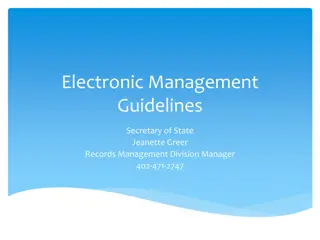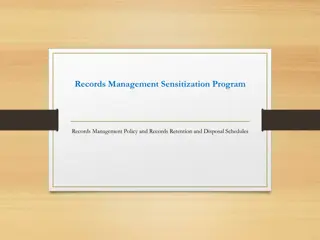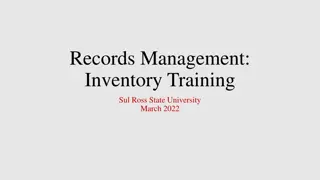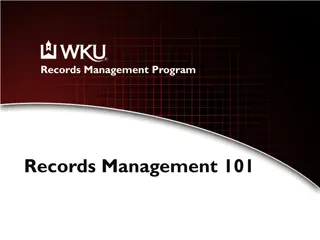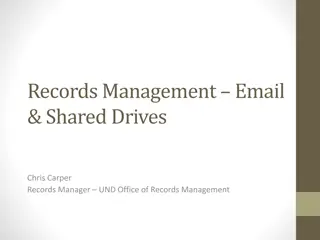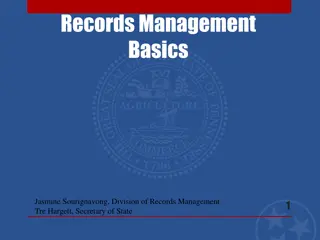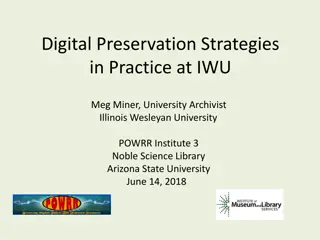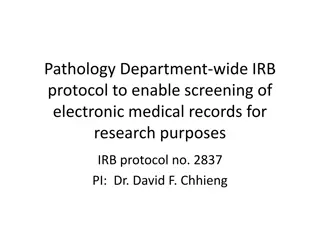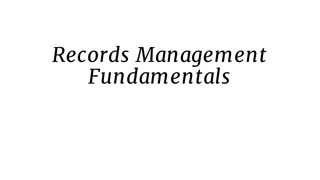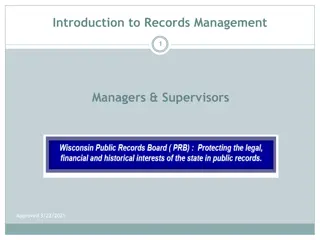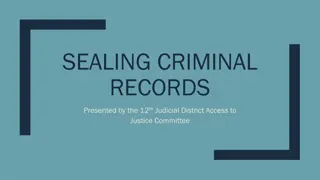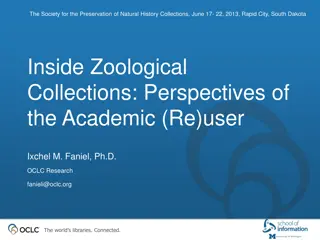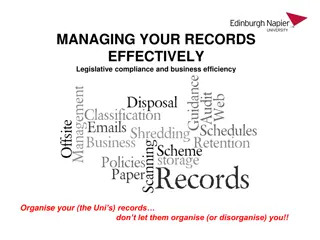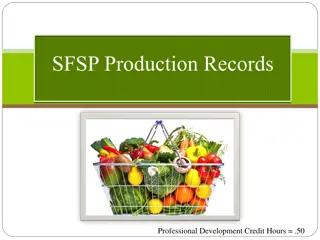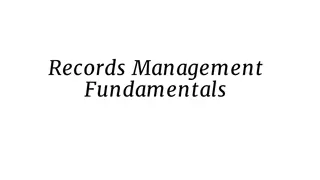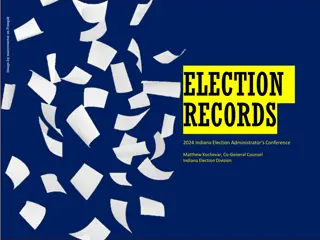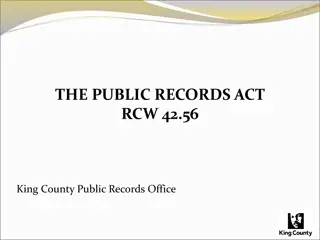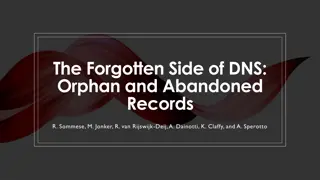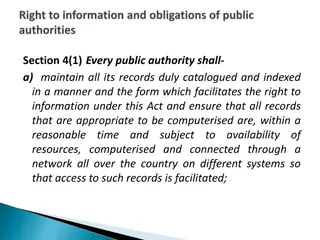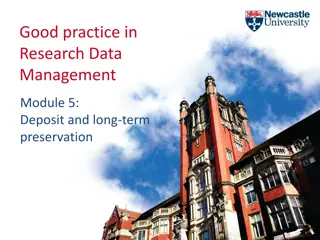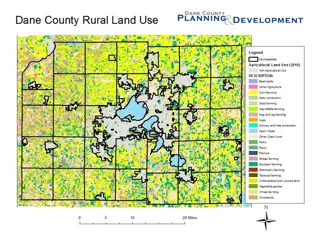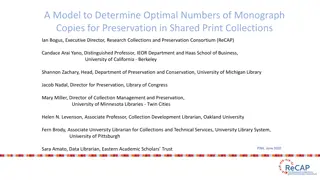Challenges and Importance of Electronic Records Preservation
The proliferation of digital data poses challenges in preserving electronic records due to rapid technological changes and digital obsolescence. Obsolescence of file formats, storage media, software, and vendor lock-in threaten the integrity and accessibility of e-records. Legislation mandates the retention of electronic records for evidentiary purposes, highlighting the critical need for effective long-term preservation strategies.
Download Presentation

Please find below an Image/Link to download the presentation.
The content on the website is provided AS IS for your information and personal use only. It may not be sold, licensed, or shared on other websites without obtaining consent from the author. Download presentation by click this link. If you encounter any issues during the download, it is possible that the publisher has removed the file from their server.
E N D
Presentation Transcript
Dr Surinder Kumar Senior Technical Director National Informatics Centre, Ne w Delhi suri@nic.in
Preface Huge Digital data produced by internet, social networks, e- government and enterprise applications, migration from analogue to digital, cloud based applications, machine to machine and mobile communication, etc. The explosion of digital information has caught us unprepared to handle the threats posed by rapidly changing technologies and digital obsolescence of computer hardware, software, file formats and storage media. Digital preservation is a complex process and there are many unsolved organizational, managerial and technical issues that make digital preservation a challenging task
Electronic Recordswhat it is As per ISO 15489-1:2001 standard, it defines records as "information created, received, and maintained as evidence and information by an organization or person, in pursuance of legal obligations or in the transaction of business". As per the IT ACT 2000 "electronic record" means data, record or data generated, image or sound stored, received or sent in an electronic form or micro film or computer generated micro fiche. The electronic records or digital content are produced in the form of text, images, documents, e-files, audio, video, 3D models, web pages, maps, datasets, computer generated micro fiche and various other forms.
Need for Preserving e-records Threat of Digital Obsolescence Huge amount of electronic data is being produced on account of Central and State level initiatives of e- governance across various domains Obsolescence of e-records is much faster on account of obsolescence of file format, storage media, database, software and vendor lock-in. The obsolescence of e-records and the evidentiary proofs can create problems in administrative, judiciary and legislative functions in addition to loss of valuable information, intellectual property and heritage.
Need contd it is necessary to ensure that the e-records which require to be retained for long duration are produced by incorporating the guidelines to ensure its long term preservability.
Legal Requirement of Preserving e- Records e production of preservablee-records are defined in order to comply with IT Act which specifies the requirements for retention of electronic records (section 7) Where any law provides that documents, records or information shall be retained for any specific period and it should have the followings: the information contained to be accessible for a subsequent reference the electronic record is retained in a format which can be represented in future the details which will facilitate the identification of the origin, destination, date and time of dispatch or receipt of such electronic record available in the electronic record:
Legal Requirementcontd As per the IT Act Notifications GSR 582, the e-records creation system or software should take into account the following features of e-records- life time preservability Accessibility comprehensibility in respect of linked information evidentiary value in terms of authenticity and integrity controlled destructibility and augmentability
Legal Requirementcontd As per the Right To Information Act 2005, Chapter II, Section 4(1) every public authority is obliged to maintain all its records duly catalogued and indexed in a manner and the form which facilitates the right to information under this Act and ensure that all records that are appropriate to be computerized are, within a reasonable time, computerized and connected through a network all over the country on different systems so that access to such records is facilitated.
Retention, disposition and access policy for electronic records The concerned administrative departments must define and notify the retention, disposition and access policy / rules applicable for electronic records for the following aspects: The types of electronic records which should be captured for preservation The duration for which the e-record should be retained The guidelines for e-records retention should include - the legal requirements that need to be fulfilled. - the procedure for disposition of e-records after retention duration is over. List of e-records which will remain in the current e-gov system and the duration List of e-records which will be transferred to designated trustworthy digital repository
Characteristics of preservable e- records It should be a non-current e-record. The e-record should be stored in the form of a digital object containing fixed information content It should be stored in low risk, open, standards based formats. It should be registered with unique record identifier or accession number. It should have an enduring and evidentiary value. The preservation metadata in terms of reference, context, provenance, fixity, representation information, authenticity and access rights is captured along with the e-record. It should possible to remove such e-record along with associated metadata from the current e-government system and store it on a separate storage for archival purpose. As far as possible, it should be self contained.
. Selection criteria for capturing the e-records as fixed objects The e-records should be captured in the form of a fixed digital object on the basis of following criteria- The retention and disposition rules pertaining to e- records The legal obligations and implications of failing to reproduce such e-record in its original and authentic form in future. The value of information contained in the e-record Whether the e-record serves as the basis for other transactions The historical significance of the e-record The e-records that need to be retained for ten years or more are generally considered to be more vulnerable to change in technologies and obsolescence.
Store the e-records in low risk, open and standards based formats While storing the e-records in specific file formats it is necessary to know whether they are nonrendered or rendered e-records
File formats for e-record capture Capture of e-records stored in database as XML document format Finalized e-records stored in a database should be exported and published as XML document for machine readability, portability, re-use, interoperability and preservability XML based domain specific and standardized formats such as XBRL, ODF (ISO/IEC 26300: 2006), Office Open XML (ISO/IEC 29500: 2008), SVG, etc can also be used depending upon the type of application.
File formats for e-record capture Capture of e-records in PDF for Archival (PDFA) format 1 ISO 19005-1:2005 Use of PDF 1.4 (PDF/A-1) with Level A conformance is recommended for archival of born digital documents 1 ISO 19005-1:2005 Use of PDF 1.4 (PDF/A-1b) with Level B conformance is recommended for archival of reformatted digital documents 2 ISO 19005-2:2011 Use of ISO 32000-1 (PDF/A-2) 3 PDF/A-1a and PDF/A-1b compliance are minimum essential for e-government records as recommended in the IFEG technical standard of DeitY.
File formatscontd Image file formats JPEG2000 (ISO/IEC 15444-1:2004) and PNG (ISO/IEC 15948:2004) which support lossless compression are recommended as raster image file formats for e- governance applications as specified in Technical Standards for Interoperability Framework for e- Governance (IFEG) in India, published in 2012 by e-Gov Standards Division, Department of Electronics and Information Technology (DeitY).
Metadata and Data Standard Metadata and Data Standards For Panchayati Raj Domain Document No. PR-MDDS v1.0 XML Schema for Generic Data Elements: Specific to Land Region CodificationData XML Schema for Generic Data Elements: Specific to Person Identification XML Schema for Generic Data Elements: Common Across All the Domains Reference: http://egovstandards.gov.in/xml-schema-for- generic-data-elements-cd
METS: Metadata Encoding and Transmisson Standards The Metadata Encoding and Transmission Standard (METS) is a data encoding and transmission specification, expressed in XML, that provides the metadata necessary for both the management of digital objects and also the exchange of objects The Consultative Committee for Space Data Systems published a Reference Model for an Open Archival Information System defining the functions for archive responsible for preserving content. OAIS introduced the concepts of a Submission Information Package (SIP) and a Dissemination Information Package (DIP) as ways of bringing content into or delivering it from an archive It refers Descriptive, Technical and Preservation such as provenance, context and fixity information needed for preservation management purposes.
Guidelines for e-records storage e-records are maintained in removable storage media e.g. CD, DVD, Blu-Ray Disk, Flash Disks, LTO Tapes, etc then the e-record keepers must take care of the following- digital storage media should be selected on the basis of the following criteria- - its proven experience of longevity - capacity (appropriate for the quantity of e-records) - durability (low susceptibility to physical damage) - viability (availability of support for its long-term readability, data recovery in case of media failure) - mature and established technology The digital storage media containing the e-records should be properly numbered, classified, labeled and indexed in a register. At least two copies of the e-records should be retained The
e-records storagecontd The digital storage media should be preferably maintained in two different locations. The digital storage media should be kept in a safe, secure and temperature controlled environment as specified by the manufacturer. The e-records stored in the media need to be retained for longer duration than the lifetime of the media then it must be migrated into another media before its expiry. ISO/IEC 27002: 2005 - Code of practices for information security management for ensuring the security of the e- records archived on digital storage.
Periodic auditing of digital storage media The digital storage media should be audited periodically which involves testing, refreshing and migration until the e-records are transferred to the designated Trustworthy Digital Repository for preservation.
MEITY/NICDigital Preservtion The Ministry of Electronics and Information Technology (DeitY) has taken early steps towards envisaging a National Digital Preservation Program. The steps taken in actualizing this vision include National Study Report on Digital Preservation Requirements of India and the award of the project Centre of Excellence for Digital Preservation to CDAC Pune and CDAC Noidaand setting up e- Governance standard division
MEITY/NICDigital Preservtion Centre for Excellence in Digital Preservation has developed the following products and documents for long term preservation of electronic data. e-Records Management and Archival System named as Digitalaya in order to meet the following objectives. Electronic records management Long term archival and preservation Digital repository development Controlled access to digital resources
MEITY/NICDigital Preservtion e-Records Extraction Tool HCDC group is developing an e-Records Extraction Tool for automatic extraction of preservation metadata in compliance with eGOV-PID standard and for capturing the electronic records stored in the database of e- governance system. Digital Preservation Standard and Guidelines e-Governance standard for Preservation Information Documentation (eGOV-PID) of Electronic Records Best practices and guidelines for Production of Preservablee-Records
MEITY/NICDigital Preservtion NIC has taken a large number of digitization and building of digital repository of the following Ministries/Department: Digitization of Official Debates of Rajya Sabha Digitization of Official Records of Ministry of Corporate Affairs Digitization of Service Books of UPSC Digitization of official correspondence of MOS (Communication & IT) Digitization of Records of Ministry of Environment & Forest Judgment Information System (JUDIS) Digitization of Closed Files/Records of NIC Digitization of Records/Files of Ministry of Railways Digitization & Archiving of Digital Files of Rajya Sabha Secretariat Records of Central Insecticides Board and Registration Committess (CIBRC) Digitization and Development of web portal of Parliament Library Digitization of Negatives and Digital Photo of President Secretariats DMRC Archives Indiacode: Repository of Central Legislations
Best Practices File Formats Document Type Resolution FileFormat Clean, high contrast documents 200 DPI Black & White (Bi tonal) 300 DPI Gray scale PDF/A Searchable Documents with handwritten notes/markings, low contrast, half-tone illustrations, photographs or poor legibility PDF/A Searchable Documents and items where colour is important for accurate representation 300 DPI Gray scale PDF/A Searchable
Digitization Process GES 2015,23-25 April
Rajya Sabha Official Debates GES 2015,23-25 April
Conclusion There is need to design the e-governance application in such a way that it should captured e-records for long duration. Incorporate digital preservation best practices and standards Documents, images should be named using its unique identifier. Capture the metadata of e-records in XML format Please ensure data to be preserved in trusted digital repository
References Best Practices and Guidelines for Production of Preservable e-Records (PROPeR) e-Governance standard for Preservation Information Documentation (eGOV-PID) of Electronic Records eGOV-PID: Preservation Metadata & Schema Retention schedule for electronic records (Section J) in the Record Retention Schedule in Respect of Records Common to All Ministries / Departments - 2012 released by Department of Administrative Reforms and Public Grievances (DARPG), Government of India. National Data Sharing and Accessibility Policy (NDSAP - 2012) by Department of Science & Technology, Government of India
References Metadata and Data Standards Demographic, Version 1.1, November 2011 published by Ministry of Communications and Information Technology, Department of Electronics and Information Technology, ISO/IEC 27002: 2005 - Code of practices for information security management for ensuring the security of the e-records archived on digital storage.


